1 of 20
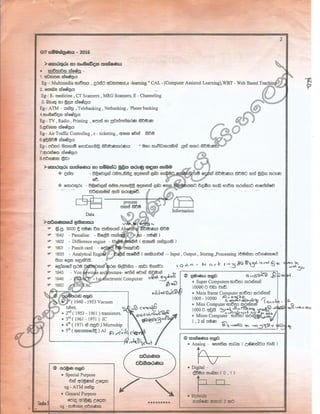
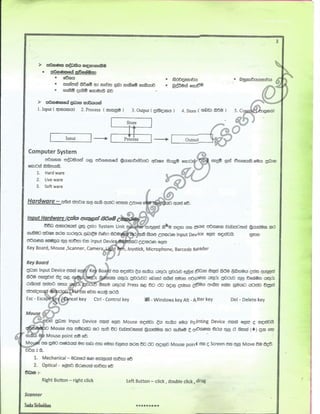


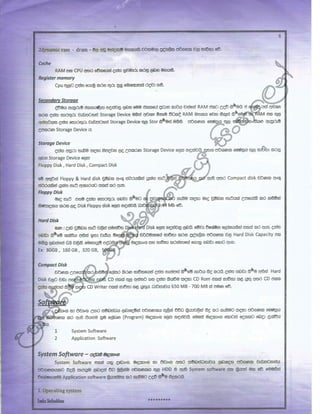

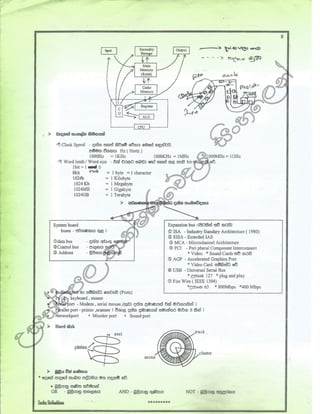
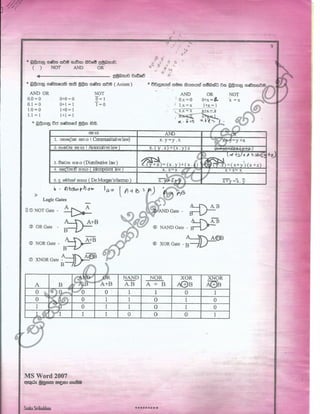



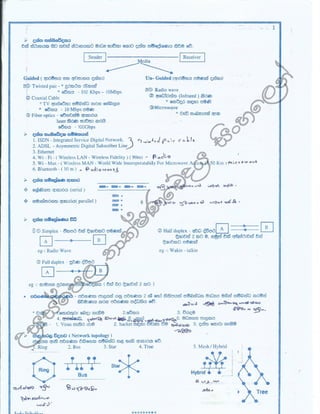
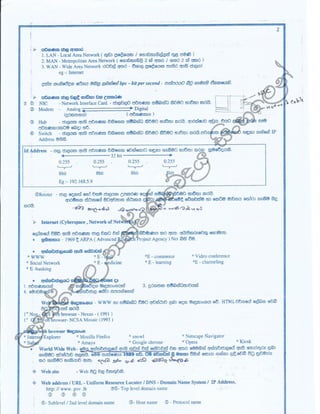



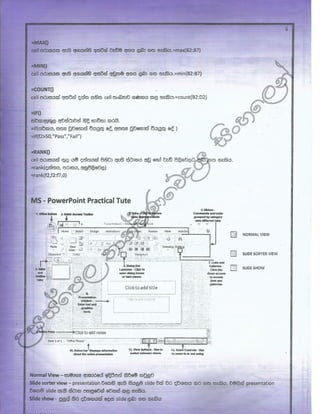
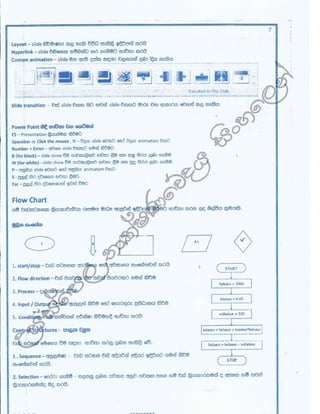


Ad
Recommended
Basics of Computer Networks in Sinhala
Basics of Computer Networks in SinhalaTharindu Weerasinghe
╠²
The document covers fundamental concepts related to computer networks, including various types such as personal, local, metropolitan, and wide area networks. It explains network protocols, focusing on the OSI and TCP/IP models, detailing their layers and functions. Additionally, the document discusses network architecture, error control, data transfer rules, and service types in networking.ict grade 12 lesson 2 sinhala medium notes pdf
ict grade 12 lesson 2 sinhala medium notes pdfruhisiya9
╠²
Grade 12 ict lesson 2
s withanage notes
sinhala medium notesDFD,Activity Diagram ,Document Flow Diagram
DFD,Activity Diagram ,Document Flow DiagramMahesh Kodituwakku
╠²
ÓĘĆÓĘÆÓĘüÓĘŖÓČĮÓĘÜÓĘüÓČÜ ÓČĖÓĘÖÓĘĆÓČĮÓČĖÓĘŖAL -ICT Networking -Questions
AL -ICT Networking -QuestionsMahesh Kodituwakku
╠²
G.C.E.A/L ICT Questions answers for the Networking lessonGIT Model Paper
GIT Model PaperMahesh Kodituwakku
╠²
This document contains 31 multiple choice questions related to computer science and information technology. The questions cover topics such as binary numbers, logic gates, file formats, operating systems, and spreadsheet functions. For each question, 4 possible answers are provided labeled i, ii, iii, and iv.G.C.E. O/L ICT(Lesson 1)
G.C.E. O/L ICT(Lesson 1)Mahesh Kodituwakku
╠²
ÓČŁÓĘ£ÓČ╗ÓČŁÓĘöÓČ╗ÓĘö ÓĘäÓĘÅ ÓĘāÓČ▒ÓĘŖÓČ▒ÓĘÆÓĘĆÓĘÜÓČ»ÓČ▒ ÓČŁÓĘÅÓČÜÓĘŖÓĘéÓČ½ÓČ║ ÓČ┤ÓĘģÓČĖÓĘöÓĘĆÓČ▒ ÓČÆÓČÜÓČÜÓČ║Input and Output DevicesÓČåÓČ»ÓĘÅÓČ▒ ÓĘäÓĘÅ ÓČ┤ÓĘŖŌĆŹÓČ╗ÓČŁÓĘÆÓČ»ÓĘÅÓČ▒ ÓČŗÓČ┤ÓĘÅÓČéÓČ£
Input and Output DevicesÓČåÓČ»ÓĘÅÓČ▒ ÓĘäÓĘÅ ÓČ┤ÓĘŖŌĆŹÓČ╗ÓČŁÓĘÆÓČ»ÓĘÅÓČ▒ ÓČŗÓČ┤ÓĘÅÓČéÓČ£Mahesh Kodituwakku
╠²
This document provides information about the educational background and professional skills of an individual. It then summarizes their experience in four areas: teaching, digital photography, scanning, and printing. For each area, key aspects are outlined such as the types of equipment used and capabilities. Functions of common devices like digital cameras, scanners, printers, and computers are also summarized briefly.Operating Systems::: G.C.E O/L
Operating Systems::: G.C.E O/LMahesh Kodituwakku
╠²
This document provides an overview of operating systems and their components. It discusses hardware (1), firmware (2), and software (3) as the main parts of an operating system. Firmware includes the BIOS that initiates the boot process. Software is divided into firmware, operating systems, and applications. The document then discusses the boot process (A-F) and describes different types of software: operating systems, device drivers, anti-virus software, and productivity applications. It also covers user interfaces, both command-line interfaces (CLIs) and graphical user interfaces (GUIs).ICT
ICTMahesh Kodituwakku
╠²
This document provides a summary of the professional experience and qualifications of an ICT professional. It includes the following information in 3 sentences:
The professional has a BTec in UG and postgraduate qualifications including an MCTS, MIEEE, and completed a professional development course in ICT in Thailand. They have over 5-10 years of experience and have worked on 4 major projects. The professional also has experience in areas such as web development, software development, networking, database development, multimedia development, graphic design, and computer training.ÓČ»ÓČŁÓĘŖÓČŁ ÓĘāÓĘä ÓČŁÓĘ£ÓČ╗ÓČŁÓĘöÓČ╗ÓĘö
ÓČ»ÓČŁÓĘŖÓČŁ ÓĘāÓĘä ÓČŁÓĘ£ÓČ╗ÓČŁÓĘöÓČ╗ÓĘöTennyson
╠²
This document discusses the input, process, and output of data information. It defines different types of data like image, video, audio, and text data. It also outlines some key aspects of turning data into meaningful information like making it less meaningless, having value and completeness, and being timely and useful. The document notes that hardware, software, and liveware are needed to transform data into useful information for end users.AL ICT -Part 2
AL ICT -Part 2Mahesh Kodituwakku
╠²
ÓČŗÓĘāÓĘāÓĘŖ ÓČ┤ÓĘÖÓĘģ ÓČŁÓĘ£ÓČ╗ÓČŁÓĘöÓČ╗ÓĘö ÓĘäÓĘÅ ÓĘāÓČ▒ÓĘŖÓČ▒ÓĘÆÓĘĆÓĘÜÓČ»ÓČ▒ ÓČŁÓĘÅÓČÜÓĘŖÓĘéÓČ½ÓČ║ÓȦ ÓČģÓČ»ÓĘÅÓČĮ ÓĘāÓĘÆÓČ║ÓČĮÓĘöÓČĖ ÓČÆÓČÜÓČÜ ÓČåÓĘĆÓČ╗ÓČ▒ÓČ║ ÓĘĆÓČ▒ ÓČ┤ÓĘ£ÓČŁÓĘŖ ÓČ»ÓĘÖÓČÜÓČćÓČĮÓĘŖÓČ£ÓĘ£ÓČ╗ÓĘÆÓČŁÓČĖ 11 ÓĘüÓĘŖŌĆŹÓČ╗ÓĘÜÓČ½ÓĘÆÓČ║ ICT
ÓČćÓČĮÓĘŖÓČ£ÓĘ£ÓČ╗ÓĘÆÓČŁÓČĖ 11 ÓĘüÓĘŖŌĆŹÓČ╗ÓĘÜÓČ½ÓĘÆÓČ║ ICTMahesh Kodituwakku
╠²
ÓČ£ÓĘÉÓČĮÓĘōÓČĖÓĘŖ ÓĘāÓȦÓĘäÓČ▒ÓĘŖ ÓĘäÓĘÅ ÓĘĆÓĘŖŌĆŹÓČ║ÓĘÅÓČóÓČÜÓĘÜÓČŁ ÓČĘÓĘÅÓĘĆÓĘÆÓČŁÓČ║ÓČ┤ÓČ╗ÓĘÆÓČ£ÓČ½ÓČÜÓČ║ÓĘÜ ÓĘĆÓĘÆÓČÜÓĘÅÓĘüÓČ║
ÓČ┤ÓČ╗ÓĘÆÓČ£ÓČ½ÓČÜÓČ║ÓĘÜ ÓĘĆÓĘÆÓČÜÓĘÅÓĘüÓČ║Rajith Pemabandu
╠²
A brief History of the Computer Technology in Sinhalese.ÓČ┤ÓČ╗ÓĘÆÓČ£ÓČ½ÓČÜ ÓČ┤ÓČ╗ÓĘÆÓČ½ÓĘÅÓČĖÓČ║ Evolution of Computer sinhala
ÓČ┤ÓČ╗ÓĘÆÓČ£ÓČ½ÓČÜ ÓČ┤ÓČ╗ÓĘÆÓČ½ÓĘÅÓČĖÓČ║ Evolution of Computer sinhalaPrabath Jayawardena
╠²
ÓČ┤ÓČ╗ÓĘÆÓČ£ÓČ½ÓČÜ ÓČ┤ÓČ╗ÓĘÆÓČ½ÓĘÅÓČĖÓČ║ Computer Evolution sinhalaGrade 10 1st Term IT Notes
Grade 10 1st Term IT NotesNavinda Dissanayake
╠²
ICT plays an important role in many areas including education, business, healthcare and more. In education, ICT facilitates computer-aided learning and teaching, allowing for online or distance learning. It helps automate school administration tasks like keeping student records and examination results. ICT also enhances communication and data sharing across long distances through tools like email and video conferencing. Overall, ICT helps increase access to information, opportunities for learning and interaction beyond physical or geographical barriers.ÓČ┤ÓČ╗ÓĘÆÓČ£ÓČ½ÓČÜ ÓĘĆÓČ╗ÓĘŖÓČ£ÓĘōÓČÜÓČ╗ÓČ½ÓČ║
ÓČ┤ÓČ╗ÓĘÆÓČ£ÓČ½ÓČÜ ÓĘĆÓČ╗ÓĘŖÓČ£ÓĘōÓČÜÓČ╗ÓČ½ÓČ║Tennyson
╠²
This document discusses different types of computers. It describes supercomputers, mainframe computers, mini computers, server computers, workstation computers, micro computers, general purpose computers, and special purpose computers. For each type, it provides 1-2 brief defining sentences. It also discusses digital, analog, and hybrid computers.ÓČÜÓĘÅÓČ╗ÓĘŖÓČ║ÓĘÅÓČĮ ÓČÜÓĘŖŌĆŹÓČ╗ÓČĖ
ÓČÜÓĘÅÓČ╗ÓĘŖÓČ║ÓĘÅÓČĮ ÓČÜÓĘŖŌĆŹÓČ╗ÓČĖFahim Fana
╠²
ÓČĮÓĘÆÓČ┤ÓĘÆ ÓČ£ÓĘ£ÓČ½ÓĘöÓČÜÓČ╗ÓČ½ÓČ║ ÓĘäÓĘÅ ÓČĮÓĘÆÓČ┤ÓĘÆÓČ£ÓĘ£ÓČ½ÓĘö ÓČ┤ÓĘĆÓČŁÓĘŖÓĘĆÓĘÅÓČ£ÓĘÖÓČ▒ ÓČ║ÓĘÅÓČĖ-
File maintains.
More Related Content
What's hot (20)
G.C.E. O/L ICT(Lesson 1)
G.C.E. O/L ICT(Lesson 1)Mahesh Kodituwakku
╠²
ÓČŁÓĘ£ÓČ╗ÓČŁÓĘöÓČ╗ÓĘö ÓĘäÓĘÅ ÓĘāÓČ▒ÓĘŖÓČ▒ÓĘÆÓĘĆÓĘÜÓČ»ÓČ▒ ÓČŁÓĘÅÓČÜÓĘŖÓĘéÓČ½ÓČ║ ÓČ┤ÓĘģÓČĖÓĘöÓĘĆÓČ▒ ÓČÆÓČÜÓČÜÓČ║Input and Output DevicesÓČåÓČ»ÓĘÅÓČ▒ ÓĘäÓĘÅ ÓČ┤ÓĘŖŌĆŹÓČ╗ÓČŁÓĘÆÓČ»ÓĘÅÓČ▒ ÓČŗÓČ┤ÓĘÅÓČéÓČ£
Input and Output DevicesÓČåÓČ»ÓĘÅÓČ▒ ÓĘäÓĘÅ ÓČ┤ÓĘŖŌĆŹÓČ╗ÓČŁÓĘÆÓČ»ÓĘÅÓČ▒ ÓČŗÓČ┤ÓĘÅÓČéÓČ£Mahesh Kodituwakku
╠²
This document provides information about the educational background and professional skills of an individual. It then summarizes their experience in four areas: teaching, digital photography, scanning, and printing. For each area, key aspects are outlined such as the types of equipment used and capabilities. Functions of common devices like digital cameras, scanners, printers, and computers are also summarized briefly.Operating Systems::: G.C.E O/L
Operating Systems::: G.C.E O/LMahesh Kodituwakku
╠²
This document provides an overview of operating systems and their components. It discusses hardware (1), firmware (2), and software (3) as the main parts of an operating system. Firmware includes the BIOS that initiates the boot process. Software is divided into firmware, operating systems, and applications. The document then discusses the boot process (A-F) and describes different types of software: operating systems, device drivers, anti-virus software, and productivity applications. It also covers user interfaces, both command-line interfaces (CLIs) and graphical user interfaces (GUIs).ICT
ICTMahesh Kodituwakku
╠²
This document provides a summary of the professional experience and qualifications of an ICT professional. It includes the following information in 3 sentences:
The professional has a BTec in UG and postgraduate qualifications including an MCTS, MIEEE, and completed a professional development course in ICT in Thailand. They have over 5-10 years of experience and have worked on 4 major projects. The professional also has experience in areas such as web development, software development, networking, database development, multimedia development, graphic design, and computer training.ÓČ»ÓČŁÓĘŖÓČŁ ÓĘāÓĘä ÓČŁÓĘ£ÓČ╗ÓČŁÓĘöÓČ╗ÓĘö
ÓČ»ÓČŁÓĘŖÓČŁ ÓĘāÓĘä ÓČŁÓĘ£ÓČ╗ÓČŁÓĘöÓČ╗ÓĘöTennyson
╠²
This document discusses the input, process, and output of data information. It defines different types of data like image, video, audio, and text data. It also outlines some key aspects of turning data into meaningful information like making it less meaningless, having value and completeness, and being timely and useful. The document notes that hardware, software, and liveware are needed to transform data into useful information for end users.AL ICT -Part 2
AL ICT -Part 2Mahesh Kodituwakku
╠²
ÓČŗÓĘāÓĘāÓĘŖ ÓČ┤ÓĘÖÓĘģ ÓČŁÓĘ£ÓČ╗ÓČŁÓĘöÓČ╗ÓĘö ÓĘäÓĘÅ ÓĘāÓČ▒ÓĘŖÓČ▒ÓĘÆÓĘĆÓĘÜÓČ»ÓČ▒ ÓČŁÓĘÅÓČÜÓĘŖÓĘéÓČ½ÓČ║ÓȦ ÓČģÓČ»ÓĘÅÓČĮ ÓĘāÓĘÆÓČ║ÓČĮÓĘöÓČĖ ÓČÆÓČÜÓČÜ ÓČåÓĘĆÓČ╗ÓČ▒ÓČ║ ÓĘĆÓČ▒ ÓČ┤ÓĘ£ÓČŁÓĘŖ ÓČ»ÓĘÖÓČÜÓČćÓČĮÓĘŖÓČ£ÓĘ£ÓČ╗ÓĘÆÓČŁÓČĖ 11 ÓĘüÓĘŖŌĆŹÓČ╗ÓĘÜÓČ½ÓĘÆÓČ║ ICT
ÓČćÓČĮÓĘŖÓČ£ÓĘ£ÓČ╗ÓĘÆÓČŁÓČĖ 11 ÓĘüÓĘŖŌĆŹÓČ╗ÓĘÜÓČ½ÓĘÆÓČ║ ICTMahesh Kodituwakku
╠²
ÓČ£ÓĘÉÓČĮÓĘōÓČĖÓĘŖ ÓĘāÓȦÓĘäÓČ▒ÓĘŖ ÓĘäÓĘÅ ÓĘĆÓĘŖŌĆŹÓČ║ÓĘÅÓČóÓČÜÓĘÜÓČŁ ÓČĘÓĘÅÓĘĆÓĘÆÓČŁÓČ║ÓČ┤ÓČ╗ÓĘÆÓČ£ÓČ½ÓČÜÓČ║ÓĘÜ ÓĘĆÓĘÆÓČÜÓĘÅÓĘüÓČ║
ÓČ┤ÓČ╗ÓĘÆÓČ£ÓČ½ÓČÜÓČ║ÓĘÜ ÓĘĆÓĘÆÓČÜÓĘÅÓĘüÓČ║Rajith Pemabandu
╠²
A brief History of the Computer Technology in Sinhalese.ÓČ┤ÓČ╗ÓĘÆÓČ£ÓČ½ÓČÜ ÓČ┤ÓČ╗ÓĘÆÓČ½ÓĘÅÓČĖÓČ║ Evolution of Computer sinhala
ÓČ┤ÓČ╗ÓĘÆÓČ£ÓČ½ÓČÜ ÓČ┤ÓČ╗ÓĘÆÓČ½ÓĘÅÓČĖÓČ║ Evolution of Computer sinhalaPrabath Jayawardena
╠²
ÓČ┤ÓČ╗ÓĘÆÓČ£ÓČ½ÓČÜ ÓČ┤ÓČ╗ÓĘÆÓČ½ÓĘÅÓČĖÓČ║ Computer Evolution sinhalaGrade 10 1st Term IT Notes
Grade 10 1st Term IT NotesNavinda Dissanayake
╠²
ICT plays an important role in many areas including education, business, healthcare and more. In education, ICT facilitates computer-aided learning and teaching, allowing for online or distance learning. It helps automate school administration tasks like keeping student records and examination results. ICT also enhances communication and data sharing across long distances through tools like email and video conferencing. Overall, ICT helps increase access to information, opportunities for learning and interaction beyond physical or geographical barriers.ÓČ┤ÓČ╗ÓĘÆÓČ£ÓČ½ÓČÜ ÓĘĆÓČ╗ÓĘŖÓČ£ÓĘōÓČÜÓČ╗ÓČ½ÓČ║
ÓČ┤ÓČ╗ÓĘÆÓČ£ÓČ½ÓČÜ ÓĘĆÓČ╗ÓĘŖÓČ£ÓĘōÓČÜÓČ╗ÓČ½ÓČ║Tennyson
╠²
This document discusses different types of computers. It describes supercomputers, mainframe computers, mini computers, server computers, workstation computers, micro computers, general purpose computers, and special purpose computers. For each type, it provides 1-2 brief defining sentences. It also discusses digital, analog, and hybrid computers.Input and Output DevicesÓČåÓČ»ÓĘÅÓČ▒ ÓĘäÓĘÅ ÓČ┤ÓĘŖŌĆŹÓČ╗ÓČŁÓĘÆÓČ»ÓĘÅÓČ▒ ÓČŗÓČ┤ÓĘÅÓČéÓČ£
Input and Output DevicesÓČåÓČ»ÓĘÅÓČ▒ ÓĘäÓĘÅ ÓČ┤ÓĘŖŌĆŹÓČ╗ÓČŁÓĘÆÓČ»ÓĘÅÓČ▒ ÓČŗÓČ┤ÓĘÅÓČéÓČ£Mahesh Kodituwakku
╠²
Viewers also liked (20)
ÓČÜÓĘÅÓČ╗ÓĘŖÓČ║ÓĘÅÓČĮ ÓČÜÓĘŖŌĆŹÓČ╗ÓČĖ
ÓČÜÓĘÅÓČ╗ÓĘŖÓČ║ÓĘÅÓČĮ ÓČÜÓĘŖŌĆŹÓČ╗ÓČĖFahim Fana
╠²
ÓČĮÓĘÆÓČ┤ÓĘÆ ÓČ£ÓĘ£ÓČ½ÓĘöÓČÜÓČ╗ÓČ½ÓČ║ ÓĘäÓĘÅ ÓČĮÓĘÆÓČ┤ÓĘÆÓČ£ÓĘ£ÓČ½ÓĘö ÓČ┤ÓĘĆÓČŁÓĘŖÓĘĆÓĘÅÓČ£ÓĘÖÓČ▒ ÓČ║ÓĘÅÓČĖ-
File maintains.
Html
Htmlsamanbandaraherath
╠²
HTML, or Hyper Text Markup Language, is a markup language used to describe web pages. It consists of various tags that define elements like headings, paragraphs, links, images, tables, and forms. Examples include creating text styles, forming lists, and implementing frames, which all contribute to the structure and presentation of web content.PHI class I application 2016
PHI class I application 2016Manjula Lakshakumara
╠²
01-29/2016
Public Health Inspector Class I ApplicationComputer networks
Computer networksMahesh Kodituwakku
╠²
1. The document discusses IP addresses and network architectures. Every device connected to the internet has a unique IP address that identifies it. IP addresses fall into classes A through E.
2. It also discusses private and public IP addresses, with private addresses only being accessible within a local area network.
3. The document compares the 5-layer and 7-layer network models, noting the 5-layer model is simpler but the 7-layer OSI model has more defined functions and protocols at each layer.IEEE754 32 Bit
IEEE754 32 BitMahesh Kodituwakku
╠²
- The document discusses the representation of real numbers and IEEE 754 arithmetic.
- Real numbers are represented as 32-bit integers according to the IEEE 754 standard. The most significant bit is 0 for positive numbers and 1 for negative numbers.
- An example shows converting the decimal number 25.65 to binary according to the IEEE 754 format. It results in the 32-bit string 110011001.101001.ÓČĄÓČĮÓČ»ÓĘÅÓČ║ÓĘÆÓĘĆ ÓČēÓČ£ÓĘÖÓČ▒ ÓČ£ÓČ▒ÓĘŖÓČ▒ÓĘÜ ÓČÜÓĘ£ÓĘäÓĘ£ÓČĖÓČ»?
ÓČĄÓČĮÓČ»ÓĘÅÓČ║ÓĘÆÓĘĆ ÓČēÓČ£ÓĘÖÓČ▒ ÓČ£ÓČ▒ÓĘŖÓČ▒ÓĘÜ ÓČÜÓĘ£ÓĘäÓĘ£ÓČĖÓČ»?Aurora Computer Studies
╠²
ÓČĄÓČĮÓČ»ÓĘÅÓČ║ÓĘÆÓĘĆ ÓČēÓČ£ÓĘÖÓČ▒ ÓČ£ÓĘÉÓČ▒ÓĘōÓČĖÓȦ ÓČģÓČŁÓĘŖÓĘĆÓĘÉÓČĮÓČÜÓĘŖ..ÓČŗÓĘāÓĘāÓĘŖ ÓČ┤ÓĘÖÓĘģ ÓĘĆÓĘÆÓĘéÓČ║ ÓČÜÓĘŖÓĘéÓĘÜÓČŁÓĘŖŌĆŹÓČ╗ÓČ║ ÓČŁÓĘØÓČ╗ ÓČ£ÓČ▒ÓĘŖÓČ▒ÓĘÜ ÓČÜÓĘÖÓĘāÓĘÜÓČ»?
ÓČŗÓĘāÓĘāÓĘŖ ÓČ┤ÓĘÖÓĘģ ÓĘĆÓĘÆÓĘéÓČ║ ÓČÜÓĘŖÓĘéÓĘÜÓČŁÓĘŖŌĆŹÓČ╗ÓČ║ ÓČŁÓĘØÓČ╗ ÓČ£ÓČ▒ÓĘŖÓČ▒ÓĘÜ ÓČÜÓĘÖÓĘāÓĘÜÓČ»?Aurora Computer Studies
╠²
ÓČŗÓĘāÓĘāÓĘŖ ÓČ┤ÓĘÖÓĘģ ÓĘĆÓĘÆÓĘéÓČ║ ÓČÜÓĘŖÓĘéÓĘÜÓČŁÓĘŖŌĆŹÓČ╗ÓČ║ ÓČŁÓĘØÓČ╗ ÓČ£ÓĘÉÓČ▒ÓĘōÓČĖ ÓĘāÓČĖÓĘŖÓČČÓČ▒ÓĘŖÓČ░ ÓČÜÓĘÖÓȦÓĘÆ ÓČĖÓČ£ÓČ┤ÓĘÖÓČ▒ÓĘŖÓĘĆÓĘōÓČĖÓČÜÓĘŖ.Innovating Digital Education #ind15
Innovating Digital Education #ind15Oliver Quinlan
╠²
Presentation at Internetdargana 2015 in Stockholm, Sweden on Nesta's work in innovation in Digital Education in the UK.Computing in English Education #ind15
Computing in English Education #ind15Oliver Quinlan
╠²
The document discusses the state of computing education in the UK, highlighting the necessity for a robust curriculum that covers computer science, ICT, and digital literacy. It emphasizes the achievement gap in education linked to socio-economic backgrounds and the importance of engaging students with practical programming skills. The national curriculum encourages understanding of fundamental computing principles, problem-solving through programming, and responsible digital citizenship.ÓČåÓČ╗ÓĘŖÓČ«ÓĘÆÓČÜÓĘĆ ÓČ»ÓĘÆÓČ║ÓĘöÓČ½ÓĘö ÓČ╗ÓȦÓČÜÓĘŖ ÓČ£ÓĘ£ÓČ®ÓČ▒ÓČ£ÓČ▒ÓĘŖÓČ▒ÓĘÜ ÓČÜÓĘÖÓĘāÓĘÜÓČ»?
ÓČåÓČ╗ÓĘŖÓČ«ÓĘÆÓČÜÓĘĆ ÓČ»ÓĘÆÓČ║ÓĘöÓČ½ÓĘö ÓČ╗ÓȦÓČÜÓĘŖ ÓČ£ÓĘ£ÓČ®ÓČ▒ÓČ£ÓČ▒ÓĘŖÓČ▒ÓĘÜ ÓČÜÓĘÖÓĘāÓĘÜÓČ»?Aurora Computer Studies
╠²
ÓČåÓČ╗ÓĘŖÓČ«ÓĘÆÓČÜÓĘĆ ÓČ»ÓĘÆÓČ║ÓĘöÓČ½ÓĘö ÓČ╗ÓȦÓČÜÓĘŖ ÓČ£ÓĘ£ÓČ®ÓČ▒ÓČ£ÓČ▒ÓĘŖÓČ▒ÓȦ ÓČģÓĘĆÓĘüÓĘŖŌĆŹÓČ║ ÓČ┤ÓĘŖŌĆŹÓČ╗ÓČ░ÓĘÅÓČ▒ ÓČÜÓČ╗ÓĘöÓČ½ÓĘö Sara Refaeli.docx Resume 2015
Sara Refaeli.docx Resume 2015Sara Refaeli
╠²
This document is a resume for Sara Refaeli, providing an overview of her qualifications and experience in sales and business development. She has over 25 years of experience in sales, business development, account management, and new client acquisition across multiple industries. Her most recent role was as a Business Development Manager at Seashore Fruit & Produce, where she increased revenue by 30% and brought in over $1 million in new business.Study BIT-UCSC @ Aurora Computer Studies
Study BIT-UCSC @ Aurora Computer StudiesAurora Computer Studies
╠²
The document provides an overview of the Bachelor of Information Technology (BIT) degree offered by the University of Colombo School of Computing (UCSC) through Aurora Computer Studies. The 3-year BIT degree covers topics like programming, databases, web development, mathematics, and business subjects. Aurora provides study materials, an online learning platform, and classroom instruction to help students earn the degree. Their goal is to equip students with both technical skills and a professional approach to launch IT careers. Contact information is included for those interested in learning more.Team building and team work (Sinhala)
Team building and team work (Sinhala)Krishantha Jayasundara
╠²
Team building is a collective term for various types of activities used to enhance social relations and define roles within teams, often involving collaborative tasks. It is distinct from team training, which is designed to improve the efficiency, rather than interpersonal relations.Data Structure and Algorithms
Data Structure and AlgorithmsMahesh Kodituwakku
╠²
This document explains how to solve the equation (A+B)*C when A=3, B=4, and C=5 using reverse polish notation. It shows that the steps are: 1) Pushing 3 and 4 onto the stack, adding them to get 7, and pushing 7 onto the stack. 2) Pushing 5 onto the stack and multiplying it by 7 to get 35. The overall solution is 35.Joomla ÓĘäÓĘÆ User Registration ÓČ£ÓĘÉÓČ▒ ÓČ»ÓĘÉÓČ▒ ÓČ£ÓČ▒ÓĘÆÓČĖÓĘö
Joomla ÓĘäÓĘÆ User Registration ÓČ£ÓĘÉÓČ▒ ÓČ»ÓĘÉÓČ▒ ÓČ£ÓČ▒ÓĘÆÓČĖÓĘöMahesh Kodituwakku
╠²
ÓČóÓĘ¢ÓČĖÓĘŖÓČĮÓĘÅ 3.4 ÓĘāÓČéÓĘāÓĘŖÓČÜÓČ╗ÓČ½ÓČ║ÓĘÖÓĘäÓĘÆ ÓĘäÓĘÆ User Registration ÓČ£ÓĘÉÓČ▒ ÓČ»ÓĘÉÓČ▒ ÓČ£ÓČ▒ÓĘÆÓČĖÓĘö
ÓČŗÓĘāÓĘāÓĘŖ ÓČ┤ÓĘÖÓĘģ ÓĘĆÓĘÆÓĘéÓČ║ ÓČÜÓĘŖÓĘéÓĘÜÓČŁÓĘŖŌĆŹÓČ╗ÓČ║ ÓČŁÓĘØÓČ╗ ÓČ£ÓČ▒ÓĘŖÓČ▒ÓĘÜ ÓČÜÓĘÖÓĘāÓĘÜÓČ»?
ÓČŗÓĘāÓĘāÓĘŖ ÓČ┤ÓĘÖÓĘģ ÓĘĆÓĘÆÓĘéÓČ║ ÓČÜÓĘŖÓĘéÓĘÜÓČŁÓĘŖŌĆŹÓČ╗ÓČ║ ÓČŁÓĘØÓČ╗ ÓČ£ÓČ▒ÓĘŖÓČ▒ÓĘÜ ÓČÜÓĘÖÓĘāÓĘÜÓČ»?Aurora Computer Studies
╠²
ÓČåÓČ╗ÓĘŖÓČ«ÓĘÆÓČÜÓĘĆ ÓČ»ÓĘÆÓČ║ÓĘöÓČ½ÓĘö ÓČ╗ÓȦÓČÜÓĘŖ ÓČ£ÓĘ£ÓČ®ÓČ▒ÓČ£ÓČ▒ÓĘŖÓČ▒ÓĘÜ ÓČÜÓĘÖÓĘāÓĘÜÓČ»?
ÓČåÓČ╗ÓĘŖÓČ«ÓĘÆÓČÜÓĘĆ ÓČ»ÓĘÆÓČ║ÓĘöÓČ½ÓĘö ÓČ╗ÓȦÓČÜÓĘŖ ÓČ£ÓĘ£ÓČ®ÓČ▒ÓČ£ÓČ▒ÓĘŖÓČ▒ÓĘÜ ÓČÜÓĘÖÓĘāÓĘÜÓČ»?Aurora Computer Studies
╠²
Ad
More from NoteGun LMS (6)
04. modules and function - note gun.com
04. modules and function - note gun.comNoteGun LMS
╠²
ÓČ┤ÓČ║ÓĘÆÓČŁÓČ▒ÓĘŖ ÓČĘÓĘÅÓĘéÓĘÅÓĘĆ - ÓČĖÓĘ£ÓČ®ÓĘÆÓČ║ÓĘöÓČĮ ÓĘāÓĘä ÓĘüÓĘŖŌĆŹÓČ╗ÓĘÆÓČŁ
NoteGun.com Sri lanka
Education LMS Sign up Now03. variables - note gun.com
03. variables - note gun.comNoteGun LMS
╠²
ÓČ┤ÓČ║ÓĘÆÓČŁÓČ▒ÓĘŖ ÓČĘÓĘÅÓĘéÓĘÅÓĘĆ - ÓĘĆÓĘÆÓČĀÓČĮÓĘŖŌĆŹÓČ║ÓČ║ÓČ▒ÓĘŖ
NoteGun.com Sri lanka
Education LMS Sign up NowÓČĖÓĘ¢ÓČĮÓĘÆÓČÜ ÓČģÓČéÓČÜÓĘÆÓČŁ ÓČ┤ÓČ╗ÓĘÆÓČ┤ÓČ« ÓĘāÓĘä ÓČŗÓČ┤ÓĘÅÓČéÓČ£ ÓČ▒ÓĘÆÓČ╗ÓĘŖÓČĖÓĘÅÓČ½ÓČ║ ÓĘāÓČ│ÓĘäÓĘÅ ÓČŁÓČ╗ÓĘŖÓČÜ ÓČ»ÓĘŖÓĘĆÓĘÅÓČ╗ ÓČĘÓĘÅÓĘĆÓĘÆÓČŁÓĘÅ ÓČÜÓĘÆÓČ╗ÓĘōÓČĖ
ÓČĖÓĘ¢ÓČĮÓĘÆÓČÜ ÓČģÓČéÓČÜÓĘÆÓČŁ ÓČ┤ÓČ╗ÓĘÆÓČ┤ÓČ« ÓĘāÓĘä ÓČŗÓČ┤ÓĘÅÓČéÓČ£ ÓČ▒ÓĘÆÓČ╗ÓĘŖÓČĖÓĘÅÓČ½ÓČ║ ÓĘāÓČ│ÓĘäÓĘÅ ÓČŁÓČ╗ÓĘŖÓČÜ ÓČ»ÓĘŖÓĘĆÓĘÅÓČ╗ ÓČĘÓĘÅÓĘĆÓĘÆÓČŁÓĘÅ ÓČÜÓĘÆÓČ╗ÓĘōÓČĖNoteGun LMS
╠²
ÓČĖÓĘ¢ÓČĮÓĘÆÓČÜ ÓČģÓČéÓČÜÓĘÆÓČŁ ÓČ┤ÓČ╗ÓĘÆÓČ┤ÓČ« ÓĘāÓĘä ÓČŗÓČ┤ÓĘÅÓČéÓČ£ ÓČ▒ÓĘÆÓČ╗ÓĘŖÓČĖÓĘÅÓČ½ÓČ║ ÓĘāÓČ│ÓĘäÓĘÅ ÓČŁÓČ╗ÓĘŖÓČÜ ÓČ»ÓĘŖÓĘĆÓĘÅÓČ╗ ÓČĘÓĘÅÓĘĆÓĘÆÓČŁÓĘÅ ÓČÜÓĘÆÓČ╗ÓĘōÓČĖÓČĖÓĘ¢ÓČĮÓĘÆÓČÜ ÓČģÓČéÓČÜÓĘÆÓČŁ ÓČ┤ÓČ╗ÓĘÆÓČ┤ÓČ« ÓĘāÓĘä ÓČŗÓČ┤ÓĘÅÓČéÓČ£ ÓČ▒ÓĘÆÓČ╗ÓĘŖÓČĖÓĘÅÓČ½ÓČ║ ÓĘāÓČ│ÓĘäÓĘÅ ÓČŁÓČ╗ÓĘŖÓČÜ ÓČ»ÓĘŖÓĘĆÓĘÅÓČ╗ ÓČĘÓĘÅÓĘĆÓĘÆÓČŁÓĘÅ ÓČÜÓĘÆÓČ╗ÓĘōÓČĖ
ÓČĖÓĘ¢ÓČĮÓĘÆÓČÜ ÓČģÓČéÓČÜÓĘÆÓČŁ ÓČ┤ÓČ╗ÓĘÆÓČ┤ÓČ« ÓĘāÓĘä ÓČŗÓČ┤ÓĘÅÓČéÓČ£ ÓČ▒ÓĘÆÓČ╗ÓĘŖÓČĖÓĘÅÓČ½ÓČ║ ÓĘāÓČ│ÓĘäÓĘÅ ÓČŁÓČ╗ÓĘŖÓČÜ ÓČ»ÓĘŖÓĘĆÓĘÅÓČ╗ ÓČĘÓĘÅÓĘĆÓĘÆÓČŁÓĘÅ ÓČÜÓĘÆÓČ╗ÓĘōÓČĖNoteGun LMS
╠²
Ad
Recently uploaded (10)
Flashcards Animais brasileiros Ilustrado Verde.pdf
Flashcards Animais brasileiros Ilustrado Verde.pdfPriscilaRibeiro803210
╠²
Jogo com animais brasileirosGazetteer of Russia. Part: Populated places G-Krasno.pdf
Gazetteer of Russia. Part: Populated places G-Krasno.pdfpeivhau
╠²
Detailed gazetteer of cities, towns and villages of Russia. Census results. Name changes. Incorporations. Latitudes and longitudes.cambios_emocionales en los traumas presentes en adolescentes
cambios_emocionales en los traumas presentes en adolescentesvivianyarenivallecil
╠²
cambios emocionalesąĮą░ą║ą░ąĘ ą┐čĆąŠ ąĘą░čĆą░čģčāą▓ą░ąĮąĮčÅą┤ąŠ 1 ą║ą╗ą░čüčā kg72 2025
ąĮą░ą║ą░ąĘ ą┐čĆąŠ ąĘą░čĆą░čģčāą▓ą░ąĮąĮčÅą┤ąŠ 1 ą║ą╗ą░čüčā kg72 2025AleksSaf
╠²
ąĮą░ą║ą░ąĘ ą┐čĆąŠ ąĘą░čĆą░čģčāą▓ą░ąĮąĮčÅą┤ąŠ 1 ą║ą╗ą░čüčā 2025pdf-p-classtruncatedtext-module-lineclamped-85ulhh-style-max-lines5topik-tema...
pdf-p-classtruncatedtext-module-lineclamped-85ulhh-style-max-lines5topik-tema...Ifa Nofalia
╠²
bjbij jknkj knlk ml ko k lk lkmk k kmpom kmp kl pk km op lk ok p m k k ,l pom l pmfpoasfmasmfp om k kmp kla fpmpaf pkokmp pmppmpa fkmpo l pmo l pamfomaf afpomopafa pompo kmapofma poGazetteer of Russia. Part: Populated places A-F.pdf
Gazetteer of Russia. Part: Populated places A-F.pdfpeivhau
╠²
Detailed gazetteer of cities, towns and villages of Russia. Census results. Name changes. Incorporations. Latitudes and longitudes. Aylanmadan olinadigan soliq.2025 yil.pdf
Aylanmadan olinadigan soliq.2025 yil.pdfilxomislomov2020
╠²
soliqlar. Aylanmadan olinadigan soliq.soliq 2025.Qarshi davlat texnika universiteti.soliq stavkalari 2025 y. O'zR soliq kodeksi.Prezentatsiya 2025. yGit exam short note
- 20. fuu fl├Īigyk Wiiafm, ;dlaIKf├Ąoh isxyf,ka fja├Ł wv├║h fkd├▒,fha fnody├¤k ,oaola nj;a fuys ish┬© whs;sh l;D i;=j nj m%ldY lr├▒
